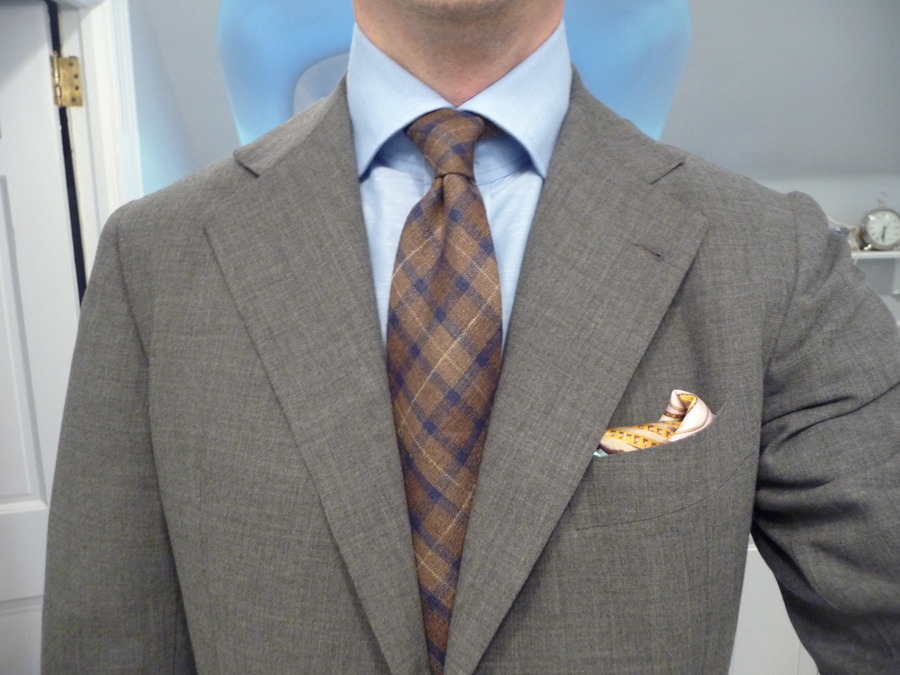
Aaron writes us to ask: I just started using pocket squares, and am not sure how to wear them best. Do you have any tips? Should they match my tie? How about my shirt? What’s the best way to put them in the pocket?
The guiding principle for pocket squares isn’t too different from the guiding principle on how to dress well in general. You don’t want to look like you didn’t put in any effort (e.g. sweatpants, flip flops, and a dirty t-shirt), but you also don’t want to look like you put in too much effort (e.g. looking like you stepped out of a fashion spread). Neither looks particularly natural or good.
For pocket squares, that means not picking things at random, otherwise your square can become a distracting element, but also not matching things too closely, otherwise you’ll look too studied. Instead, you want to your pocket square to be complementary to whatever else you’re wearing. It should seem like you grabbed something at random (even though you didn’t) and things just happened to work out well. Which means:
Color (With Respect to Your Jacket): Make sure your pocket square is a somewhat distinctive piece. If you’re wearing a navy sport coat, don’t wear a navy pocket square. Instead, choose a color that stands out a bit more, such as burgundy, brown, or even white, but don’t venture into something too loud. Again, you want this to look harmonious, not distracting.
Color (With Respect to Your Tie): You never want your pocket square and tie to match. Tie + pocket square sets made from the same fabric should never be worn (let alone bought), but you should also not recreate this kind of look with whatever items you have on hand.
Color wise, you want your pocket square to complement, but not directly mirror, your tie. There are two ways of thinking about this. The first is to choose something that subtly picks up a secondary color in your tie. So if you have a burgundy tie with navy and cream pencil stripes, you can choose a pocket square with a bit of cream to pick up the color in your tie. You would not want, however, to pick a pocket square in the exact same shade of burgundy, as this would look contrived.
The other way of thinking about this is to pick a square in color that complements the main color of your tie. That can mean choosing things in a slightly different shade, or in a color that’s either adjacent or directly across on the color wheel (navy put with a medium blue, or a dark green put with burgundy). This is somewhat trickier, however, because you run a greater risk of your pocket square either looking too thought out, or chosen at random. Best to judge on a case-to-case basis.
Material: Silk or wool pocket squares can generally be worn with almost anything, although silk – especially cream or white silk – will look a bit dressier, especially if it has a “wet,” rather than a “dry,” finish. The shinier a square is, the more formal it can look. Linen is also very versatile, except maybe with tweeds and corduroy, where a silk or wool square might be better. The traditional white linen goes with pretty much anything, however. Cotton squares should be kept to summer suits, and wool has a cold-weather feel.
Personally, I like wearing a square in a different material than my tie. So wool squares with silk ties, silk squares with wool ties, etc. This is just a personal preference, however.
How to Fold: Gilt Manual covered the three main methods. I wear mine using a slightly different technique, which is shown here by Michael Alden. I find that produces a more appealing “puff,” but you can use whatever works best for you. Just don’t use a needlessly fancy fold that makes your pocket square look like origami, and if you wear your pocket square with the points up, don’t have them stick six inches into the air. Again, you want this element to be tasteful, harmonious, and charming, but not distracting.
The Reliable White Linen: When in doubt, wear a white linen in the TV fold (or what Gilt Manual called the “traditional fold”). You’re almost always safe with that.
(Pictured above: StyleForum member Manton)
